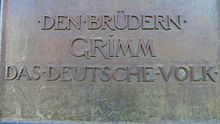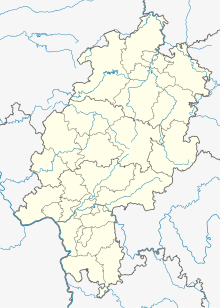Brothers Grimm National Monument
Coordinates: 50 ° 7 '58.8 " N , 8 ° 55' 1.2" E
The Brothers Grimm National Monument is a double statue for the Brothers Grimm, who were born in Hanau . It was unveiled in front of the Neustädter Rathaus in Hanau in 1896 .
prehistory
Before this came about, there had already been several attempts to erect such a monument : in 1853 - while the brothers were still alive - by Pedro Jung , in 1870 by an appeal in the press and in 1881 by the mayor of Hanau , Eduard Rauch .
draft
Only the subsequent initiative of the Hanau high school teacher and archaeologist Georg Wolff was successful. With the support of the Wetterau Society for All Natural History and the Hanau History Association , things got rolling. On January 21, 1884, a memorial committee was established. First of all, the priority of the city of Hanau as the location for a national monument had to be enforced over Kassel , Göttingen and Berlin , which was successful. The committee and a specially founded Grimm Association took care of the organization and financing of the project, in particular through appeals for donations. Between the 100th birthday of Jacob Grimm in 1885 and that of Wilhelm Grimm in 1886, more than 60,000 marks were donated. The Prussian state promised a further 25,000 marks in return for a say in the selection of the design for the monument.
The shape of the monument was discussed. The classicism- bound Goethe-Schiller monument in Weimar from 1857 served as a model. Romantics , who would have preferred to see the monument in the form of a fountain , turned against this in the “old German, ie Gothic style” ( neo-Gothic ).
In 1888 a limited competition was held among eleven sculptors . From January 1, 1889, the models sent in were exhibited by the public at the Hanau Drawing Academy with lively sympathy and sometimes mocking criticism. On January 17, 1889, the jury made a selection. Three prizes were awarded: 1st prize (with 2,500 marks in prize money) went to Max Wiese , director of the drawing academy, 2nd prize (1,500 marks) Gustav Eberlein ( Berlin ), 3rd prize (1,000 marks) Syrius Eberle ( Munich ) . The jury's decision was controversial, criticized in public and disavowed by the dispute between the artists. In this situation the committee decided to question Wilhelm Grimm's son, the art and literary historian Herman Grimm . He came to the conclusion that Syrius Eberle had created the model that most closely represented the work of his father and his uncle. Since the monument committee was also in dispute with Max Wiese, it commissioned Syrius Eberle to carry it out in 1891. However, this meant that the Prussian state felt restricted in its rights of participation and withdrew its funding commitment.
execution
A double statue was made, showing the two scholars as full-body figures larger than life, Wilhelm Grimm sitting and Jacob Grimm standing. The total height is almost six and a half meters. According to a legend widespread in Hanau, both figures are supposed to swap positions at midnight.
Neustädter Marktplatz in Hanau was chosen as the location . This required a larger base compared to the design. This - including the allegorical reliefs attached - was designed by the architect Friedrich von Thiersch together with the ornamental grille surrounding the monument. Carried out in this way, a total price of 95,000 marks was estimated. But now the artist was behind schedule, and it was not until 1894 that he had completed a model on a 1: 1 scale. By and large, it appealed to the Hanau Committee; however, the artist was not satisfied and destroyed it. The following year he had created a new model. The monument was finally unveiled on October 18, 1896.
Aftermath
The original-sized plaster model, without a base, was placed in the Murhard library in the Museum Fridericianum in Kassel and destroyed in the Second World War. Only the heads of the two figures could be saved from the rubble and are now in the Brothers Grimm Museum in Kassel. The national monument in Hanau survived all air raids and is now also a cultural monument according to the Hessian Monument Protection Act . The three award-winning models of the competition are also preserved in the Hanau Historical Museum .
An impression of the national monument was made in 1989 and was set up in the Kofuko amusement park near the town of Obihiro on the Japanese island of Hokkaidō .
literature
- Karl Dielmann: The award-winning models for the national monument of the Brothers Grimm in Hanau . In: From Hessian museums 1. Kassel 1975. Ed .: Hessischer Museumsverband , pp. 143–154.
- Richard Schaffer-Hartmann: The Brothers Grimm Monument in Hanau - history of a national monument . Hanau 2008, ISBN 978-3-937774-68-8 .
- Richard Schaffer-Hartmann: The Brothers Grimm in Hanau - immortalized in bronze. In: Brothers Grimm Journal. 2, 2007, p. 2ff.
- Welf-Gerrit Otto: There was little talk of Grimm. Changes in the use of the Hanau national monument. In: Hessian Association for Folklore (Hrsg.): Between Identity and Image - The popularity of the Brothers Grimm and their fairy tales in Hesse. (= Hessian papers for folk and cultural research. 44/45). Marburg 2008, ISBN 978-3-89445-414-2 , pp. 52-119.
Web links
Remarks
- ↑ "In this way, the 'fairy-tale' and 'funny' that the Brothers Grimm have revived from the depths of the German people's soul and given back to the nation could be embodied in an excellent way and a truly folk-like work created." Deutsche Bauzeitung , Volume 19, 1885, p. 135.)
Individual evidence
- ↑ Deutsche Bauzeitung , Volume 19, 1885, p. 135.
- ↑ Deutsche Bauzeitung , 23rd year 1889, p. 47.
- ↑ Deutsche Bauzeitung , Volume 30, 1896, p. 543.
- ^ Carolin Krumm: Cultural monuments in Hessen - City of Hanau . Ed .: State Office for Monument Preservation Hessen . Wiesbaden 2006, ISBN 3-8062-2054-9 , p. 150.





